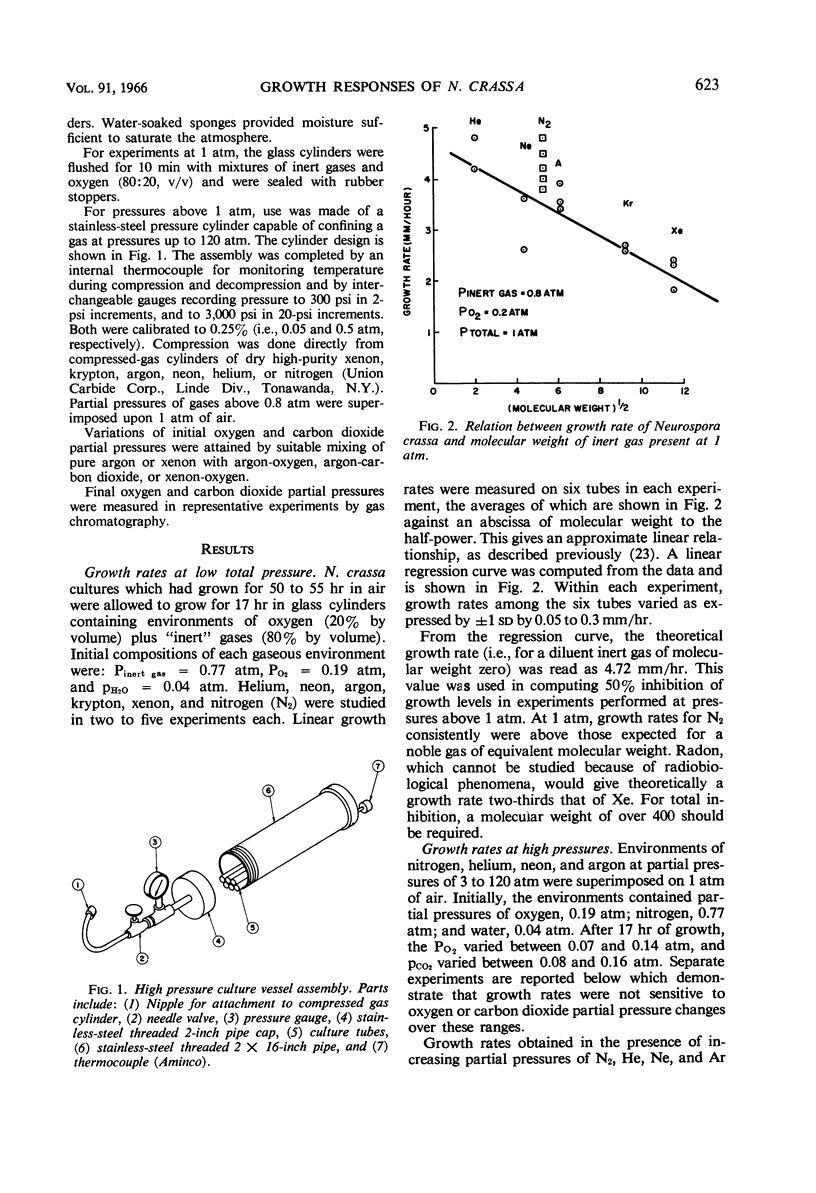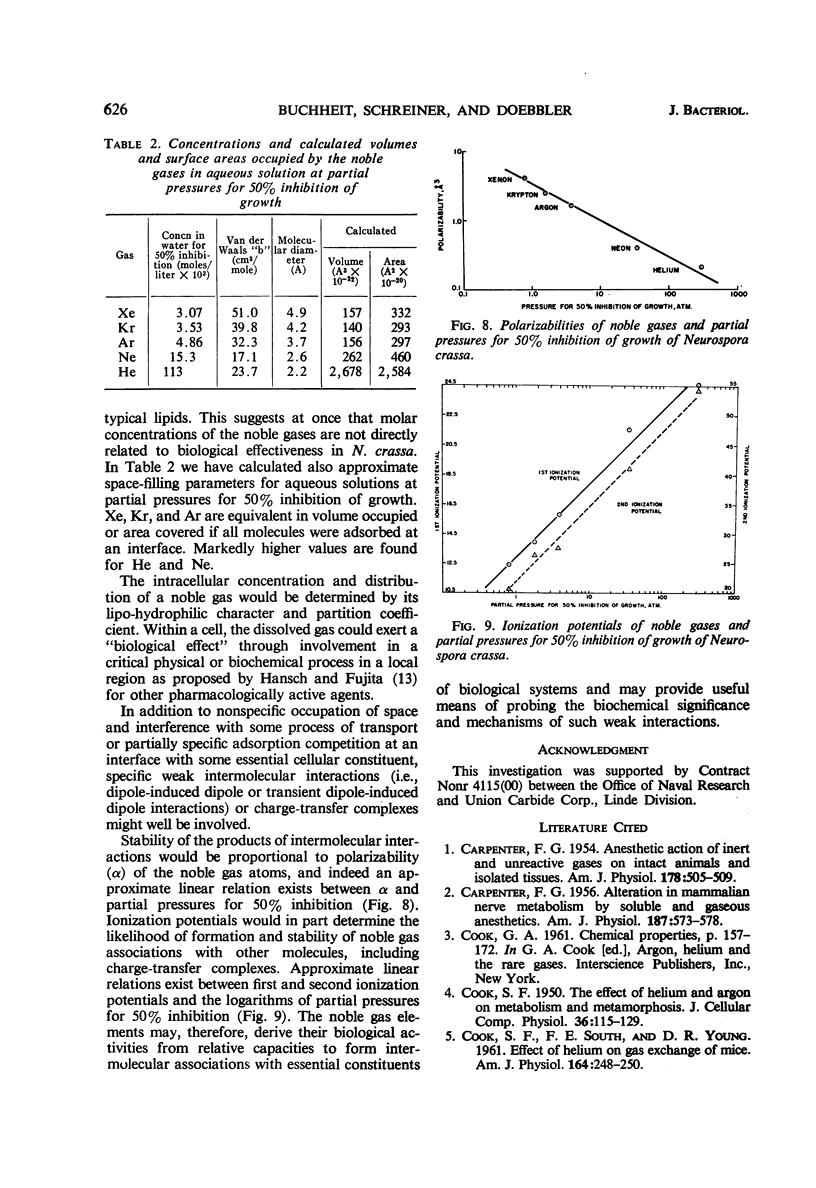Abstract
Buchheit, R. G. (Union Carbide Corp., Tonawanda, N.Y.), H. R. Schreiner, and G. F. Doebbler. Growth responses of Neurospora crassa to increased partial pressures of the noble gases and nitrogen. J. Bacteriol. 91:622–627. 1966.—Growth rate of the fungus Neurospora crassa depends in part on the nature of metabolically “inert gas” present in its environment. At high partial pressures, the noble gas elements (helium, neon, argon, krypton, and xenon) inhibit growth in the order: Xe > Kr> Ar ≫ Ne ≫ He. Nitrogen (N2) closely resembles He in inhibitory effectiveness. Partial pressures required for 50% inhibition of growth were: Xe (0.8 atm), Kr (1.6 atm), Ar (3.8 atm), Ne (35 atm), and He (∼ 300 atm). With respect to inhibition of growth, the noble gases and N2 differ qualitatively and quantitatively from the order of effectiveness found with other biological effects, i.e., narcosis, inhibition of insect development, depression of O2-dependent radiation sensitivity, and effects on tissue-slice glycolysis and respiration. Partial pressures giving 50% inhibition of N. crassa growth parallel various physical properties (i.e., solubilities, solubility ratios, etc.) of the noble gases. Linear correlation of 50% inhibition pressures to the polarizability and of the logarithm of pressure to the first and second ionization potentials suggests the involvement of weak intermolecular interactions or charge-transfer in the biological activity of the noble gases.
Full text
PDF





Selected References
These references are in PubMed. This may not be the complete list of references from this article.
- CARPENTER F. G. Alteration in mammalian nerve metabolism by soluble and gaseous anesthetics. Am J Physiol. 1956 Dec;187(3):573–578. doi: 10.1152/ajplegacy.1956.187.3.573. [DOI] [PubMed] [Google Scholar]
- CARPENTER F. G. Anesthetic action of inert and unreactive gases on intact animals and isolated tissues. Am J Physiol. 1954 Sep;178(3):505–509. doi: 10.1152/ajplegacy.1954.178.3.505. [DOI] [PubMed] [Google Scholar]
- COOK S. F., SOUTH F. E., Jr, YOUNG D. R. Effect of helium on gas exchange of mice. Am J Physiol. 1951 Jan;164(1):248–250. doi: 10.1152/ajplegacy.1950.164.1.248. [DOI] [PubMed] [Google Scholar]
- COOK S. F. The effect of helium and argon on metabolism and metamorphosis. J Cell Physiol. 1950 Aug;36(1):115–127. doi: 10.1002/jcp.1030360109. [DOI] [PubMed] [Google Scholar]
- EBERT M., HORNSEY S., HOWARD A. Effect of inert gases on oxygen-dependent radiosensitivity. Nature. 1958 Mar 1;181(4609):613–616. doi: 10.1038/181613a0. [DOI] [PubMed] [Google Scholar]
- FEATHERSTONE R. M., MUEHLBAECHER C. A., DEBON F. L., FORSAITH J. A. Interactions of inert anesthetic gases with proteins. Anesthesiology. 1961 Nov-Dec;22:977–981. doi: 10.1097/00000542-196111000-00018. [DOI] [PubMed] [Google Scholar]
- FENN W. O. PHARMACOLOGY IN HYPERBARIC OXYGENATION. INERT GAS NARCOSIS. Ann N Y Acad Sci. 1965 Jan 21;117:760–767. [PubMed] [Google Scholar]
- FERGUSON J., HAWKINS S. W. Toxic action of some simple gases at high pressure. Nature. 1949 Dec 3;164(4179):963–963. doi: 10.1038/164963c0. [DOI] [PubMed] [Google Scholar]
- FRANKEL J., SCHNEIDERMAN H. A. The effects of nitrogen, helium, argon and sulfur hexafluoride on the development of insects. J Cell Physiol. 1958 Dec;52(3):431–451. doi: 10.1002/jcp.1030520305. [DOI] [PubMed] [Google Scholar]
- GOTTLIEB S. F., WEATHERLY J. M. PHYSIOLOGICAL EFFECTS OF THE NOBLE GASES ON FROG SCIATIC NERVE AND GASTROCNEMIUS MUSLCE. Am J Physiol. 1965 Mar;208:407–411. doi: 10.1152/ajplegacy.1965.208.3.407. [DOI] [PubMed] [Google Scholar]
- Lawrence J. H., Loomis W. F., Tobias C. A., Turpin F. H. Preliminary observations on the narcotic effect of xenon with a review of values for solubilities of gases in water and oils. J Physiol. 1946 Dec 6;105(3):197–204. [PMC free article] [PubMed] [Google Scholar]
- MILLER S. L. A theory of gaseous anesthetics. Proc Natl Acad Sci U S A. 1961 Sep 15;47:1515–1524. doi: 10.1073/pnas.47.9.1515. [DOI] [PMC free article] [PubMed] [Google Scholar]
- Miller K. W., Paton W. D., Smith E. B. Site of action of general anaesthetics. Nature. 1965 May 8;206(984):574–577. doi: 10.1038/206574a0. [DOI] [PubMed] [Google Scholar]
- NICHOLAS D. J., NASON A., McELROY W. D. Molybdenum and nitrate reductase. I. Effect of molybdenum deficiency on the Neurospora enzyme. J Biol Chem. 1954 Mar;207(1):341–351. [PubMed] [Google Scholar]
- PAULING L. A molecular theory of general anesthesia. Science. 1961 Jul 7;134(3471):15–21. doi: 10.1126/science.134.3471.15. [DOI] [PubMed] [Google Scholar]
- SOUTH F. E., Jr, COOK S. F. Argon, xenon, hydrogen, and the oxygen consumption and glycolysis of mouse tissue slices. J Gen Physiol. 1954 Jan 20;37(3):335–341. doi: 10.1085/jgp.37.3.335. [DOI] [PMC free article] [PubMed] [Google Scholar]
- Schreiner H. R., Gregoire R. C., Lawrie J. A. New Biological Effect of the Gases of the Helium Group. Science. 1962 May 18;136(3516):653–654. doi: 10.1126/science.136.3516.653. [DOI] [PubMed] [Google Scholar]


